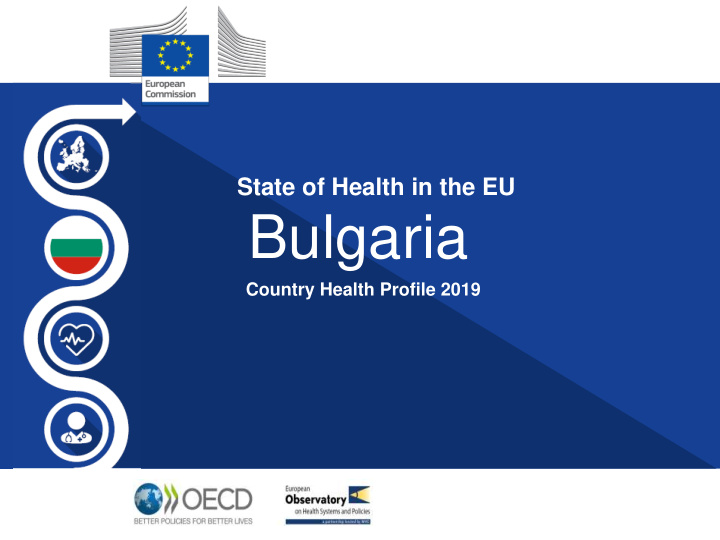



State of Health in the EU Bulgaria Country Health Profile 2019
Agenda 1 Highlights 2 Health in Bulgaria 3 Risk Factors 4 The Health System 5 Performance of the Health System 6 Key Findings
Bulgaria recorded the lowest life expectancy in the EU 1 2 • Life expectancy in Bulgaria increased by more than three years between 2000 and 2017 • Also inequities in life expectancy e.g. between gender as are inequities along lines of regions and incomes
Deaths due to circulatory system diseases were high, but 2 dropping 2 • Circulatory system diseases account for the highest number of deaths in Bulgaria, out of which ischaemic heart disease and stroke were principal causes of death • Rising cancer-related mortality (esp. lung cancer) is a point of concern
Behavioural risk factors remain high 3 3 • The rate of adult smoking is the highest in the EU, with more than one in four adults smoking daily in 2014 • Nearly two thirds of the adult population do not consume at least one piece of fruit each day • Obesity in adults was just below EU average, but one in five Bulgarian children was obese in 2014 (marked increase since 2005-2006)
Highest annual growth rate in health expenditures 4 4 • Bulgaria spent EUR 1 311 per capita or 8.1% of its GDP on health • continuous growth in health expenditure since 2009, outpacing the growth rate of every other EU Member State except Romania • Public financing of the health system accounted for 52.1 % of total health spending in 2017 (and lowest level for Bulgaria since 1998)
Pharmaceuticals absorb highest share of health 4 expenditure 4 • Expenditures for pharmaceutical are higher than the EU average and over 40% of total health expenditure • Inpatient care causes the second highest budget item in health expenditure • Health expenditure for outpatient care, prevention (and long-term care) are below EU average
Reduction in treatable mortality 5 5 • Mortality from causes that deemed treatable was fourth-highest in the EU • Preventable mortality is slightly worse; lung-cancer, stroke, ischaemic heart disease and hypertension contributed to a majority of preventable mortality • Tackling high behavioural risk factors is underway, but there is room for improvement in early diagnosis and treatment • Vaccine-preventable mortality is challenged by declining coverage rates
Gaps in coverage and high private costs deteriorate 5 accessibility 5 • A significant share of the population has no coverage (estimates varies between 10-14% of the total population) and have to pay directly for care • The gap in population coverage disproportionately affects the long-term unemployed, the Roma population and those living in disadvantaged areas • Bulgaria reported the highest share of private health spending in the EU in 2017 (46.6%), which was almost three times the EU average
Uneven availability of providers is marked 5 • Bulgaria has a relatively high density of doctors.. … but high regional disparities and few General Practictioners • there are only few nurses • Self-reported unmet needs for medical care was 2 % in 2017 and only slightly above EU- average (a drop by 13 percentage points compared to 2008)
A growing (private) hospital sector with much activity 5 5 • Bulgaria has the highest hospital admission rate in the EU (double the EU average) • Number of private hospitals increased six-fold between 2000 and 2016 (while number of public hospitals decreased) • Also admission rates for heart failure, diabetes and asthma can be avoided through a strong outpatient care setting that account for a tenth of all hospitalisations, where other hospitalisations could be avoided altogether
Resilience of the health system challenged 5 5 • Growth in health expenditure outpaced growth in GDP except for 2012 and 2015 • The increase in health expenditures is mainly driven by private expenditures which deepens problems of inequity and affordability • Ageing of the medical workforce and general population will cause further challenges (e.g. providing long-term care in health system not yet included)
6 Key Findings 6 • The increase in spending for primary prevention and health promotion is encouraging but implementation is weak and does not yet materialise into declines in e.g. preventable mortality • Strengthen outpatient care can help to contain hospital activity if services are accessible and provide high quality, assuming that the uneven distribution of health professionals and facilities can be overcome • Shortages of general practicioners and nurses are barriers to delivering outpatient services; strategies to increase the number of graduates and the National Health Map seek to adress these shortages • Primary care is bypassed by a third of patients by calling an ambulance or visiting an emergency ward of a hospital: uninsured being among them
6 Key Findings (II) • Containing hospital activity is vital to the health system and has been in the focus of many reform initiatives (e.g. selective contracting, stricter licencing regime, ban on new hospitals). But notably, the past few years have been marked by challenges to policy implementation and the rising influence of the national courts in this • Savings in spending on pharmaceuticals can be possible and the introduction of Health Technology Assessment is an important milestone to achieve this aim • Bringing down pharmaceutical prices is also important for private health expenditure, which are the highest in the EU (46.6%) • Gaps in coverage for around 10-14% of population is also a major concern to affordability and accessibility of care
ec.europa.eu/health/state oecd.org/health/health-systems/country-health-profiles-EU.htm 15 euro.who.int/en/about-us/partners/observatory/publications/country-health-profiles
Recommend
More recommend